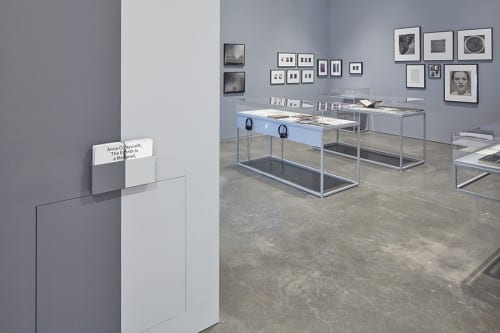
Anna Craycroft, The Earth Is a Magnet, 2016, installation view, part of The Artist’s Museum, Institute of Contemporary Art Boston, November 16, 2016–March 26, 2017 (artwork © Anna Craycroft; photographs © Berenice Abbott/Commerce Graphics Ltd. Inc; photograph by Charles Mayer)
Anna Craycroft’s new project for Art Journal Open, “To Record, to Interpret, to Comment,” does many things at once.1 From the outset, the Brooklyn–based artist poignantly makes an imperative gesture, asking readers to reconsider how we come to know what we think we know about the history of modernist photography. Reproducing personal notes, letters, and technical documentation drawn from the rich archives of the Bernice Abbott collections at the MIT Museum in Cambridge, Massachusetts, and the New York Public Library, Craycroft eloquently explicates her own twenty-first-century interpretation and commentary on Abbott’s twentieth-century technical prowess. She notes how in the 1940s, Abbott invented Super Sight, a studio process for macrophotography, and also patented a camera designed on what Abbott called the “digital principle,” which synched the depression of the camera’s shutter by the photographer’s finger with the blinking of her eye.2 Rather than a revisionist account or counter narrative to the dominant strains of modernist photographic art history, what emerges is Craycroft’s own conception of the medium: “the photograph lays claim to an incident, but it is not the incident. It exists between making and telling. The photograph is a testimony of its own event.”3
As you read and click through the links to primary material, visual evidence, and anecdotal accounts that Craycroft has organized and annotated for Art Journal Open, you will learn of Craycroft’s efforts to record, interpret, and comment on Abbott’s immeasurable influence as an inventor, educator, archivist, curator, author, and activist alongside her own contingent subjectivity. Taking note of Abbott’s pointed response, “I am photographer, not a lesbian,” to photographer Kaucyila Brooke after she requested permission to present images of Abbott’s work in her paper for the 1986 CAA conference panel “Homosexuality in the Arts: Broadening Our Critical Perspective,” Craycroft here interprets Abbott’s statement as a “declarative refusal.” Noting both the paradoxical nature of Abbott’s denunciation and the privilege of historical judgement, Craycroft reminds us that Abbott “came of age before the ratification of the Nineteenth Amendment, and made a name for herself as a photographer during McCarthyism,” helping to contextualize the extremism of the current political climate and its oppressive rhetoric on the role of women and nonconforming gender roles that continues to foment into official policy. Craycroft compellingly argues that for Abbott, “photography was an orientation.”4 “When I think of Abbott sublimating her private self into her photography, it reveals a new strength in the work. Rather than leading with individualist heroics, hers is a proud position of bearing witness,” Craycroft writes in her Art Journal Open essay, “I love the contradiction here, as witness is commonly considered a second-class status of subjugation, something that is foisted on one, rather than a choice. For centuries it was the only option available to women who may have wanted to act but were refused. Even to witness is to be involved and to effect change, albeit indirectly.”
“To Record, to Interpret, to Comment” also acts as a tertiary space between two current exhibitions featuring Craycroft’s work in Boston and Los Angeles: The Artist’s Museum at the Institute of Contemporary Art, Boston, and Tuning the Room at Ben Maltz Gallery at Otis College of Art and Design, Los Angeles. For The Artist’s Museum (November 15, 2016—March 26, 2017), the curator Dan Byers invited Craycroft to collaborate on the exhibition, during which she was able to, as she writes, “reflect on how the range of Abbott’s practice expands the parameters of an artistic discipline beyond the limitation of being either singular or plural,” which resulted in her multivalent installation, The Earth Is a Magnet (2016). In addition to Abbott’s photographs and archival materials, The Earth Is a Magnet features artworks by Craycroft’s own peers to whom she invited to share her space within the exhibition: A.L. Steiner, Lucy Raven, Matt Keegan, Jill Magid, Katherine Hubbard, MPA, Mika Rottenberg, Erika Vogt, and Fia Backström. Ben Maltz Gallery presents Craycroft’s solo exhibition Tuning the Room (January 28–April 16, 2017), curated by the gallery’s director, Kate McNamara. “The measure and alterations of Craycroft’s ‘room tuning’ are framed in relation to its setting within the art gallery of an art school,” the press release for the exhibition notes, “In the wake of the U.S. presidential election, and in anticipation of the exhibition runtime falling during the first months of the new administration, Tuning the Room is a proposal to pay attention to the role that art and art education play in how voices are heard.”5
Above all, “To Record, to Interpret, to Comment” enacts the very logic Craycoft associates with Abbott’s own working methods in her essay: “that the singularity of her focus resulted in such a diversity of engagements reveals how the very discipline of being an artist can be inherently expansive.”
—Gloria Sutton, Web Editor
- This project also manifests Art Journal Open’s editorial goal of establishing benchmarks for representing artistic practice and research on the web. I want to thank Anna Craycroft herself for her ongoing generosity in sharing her work and working methods, and acknowledge the contribution of CAA’s associate editor for digital publications, Alyssa Pavley, who managed the technical side of bringing the images to the web. ↩
- Anna Craycroft, “To Record, to Interpret, to Comment,” Art Journal Open, at http://artjournal.collegeart.org/?p=8039, as of March 1, 2017. ↩
- Anna Craycroft, (A), in The Artist’s Museum, exh. cat., ed. Dan Byers (New York: Prestel, 2016), 78. ↩
- Ibid. ↩
- Ben Maltz Gallery at Otis College of Art and Design, Anna Craycroft: Tuning the Room, at http://www.otis.edu/ben-maltz-gallery/anna-craycroft-tuning-room, as of February 29, 2017. ↩

